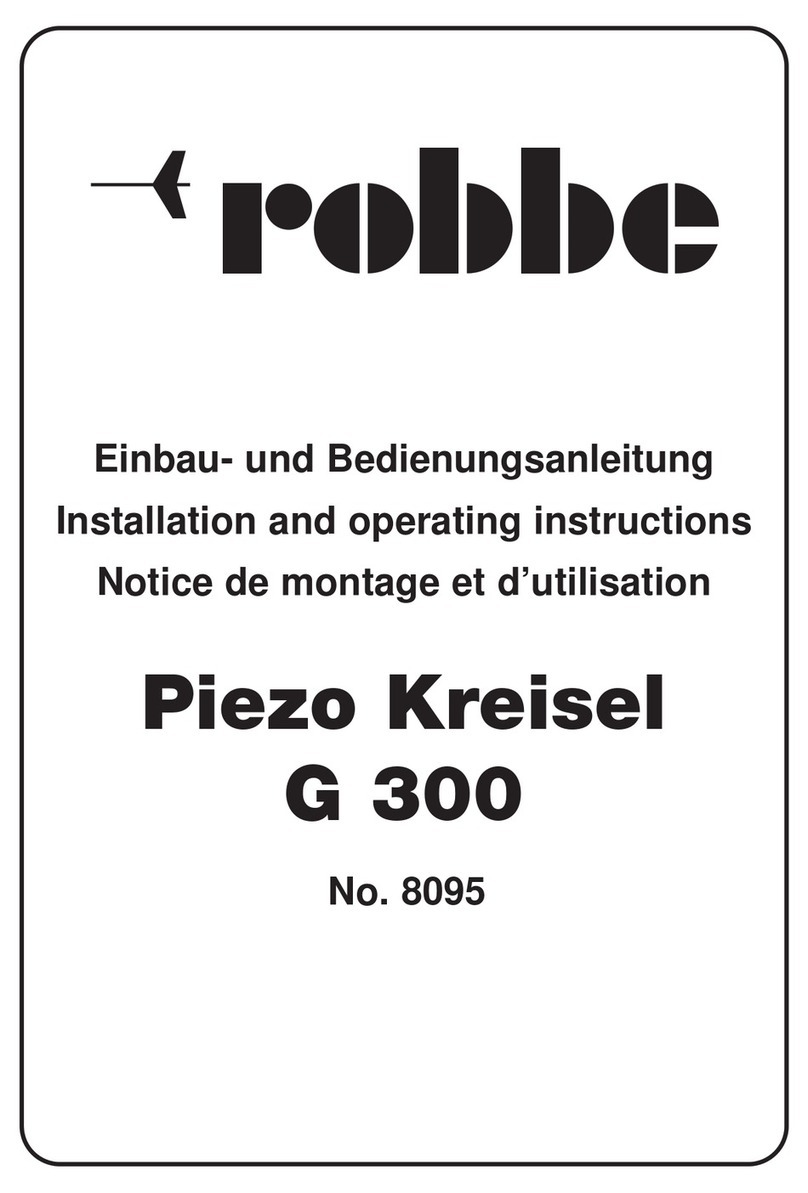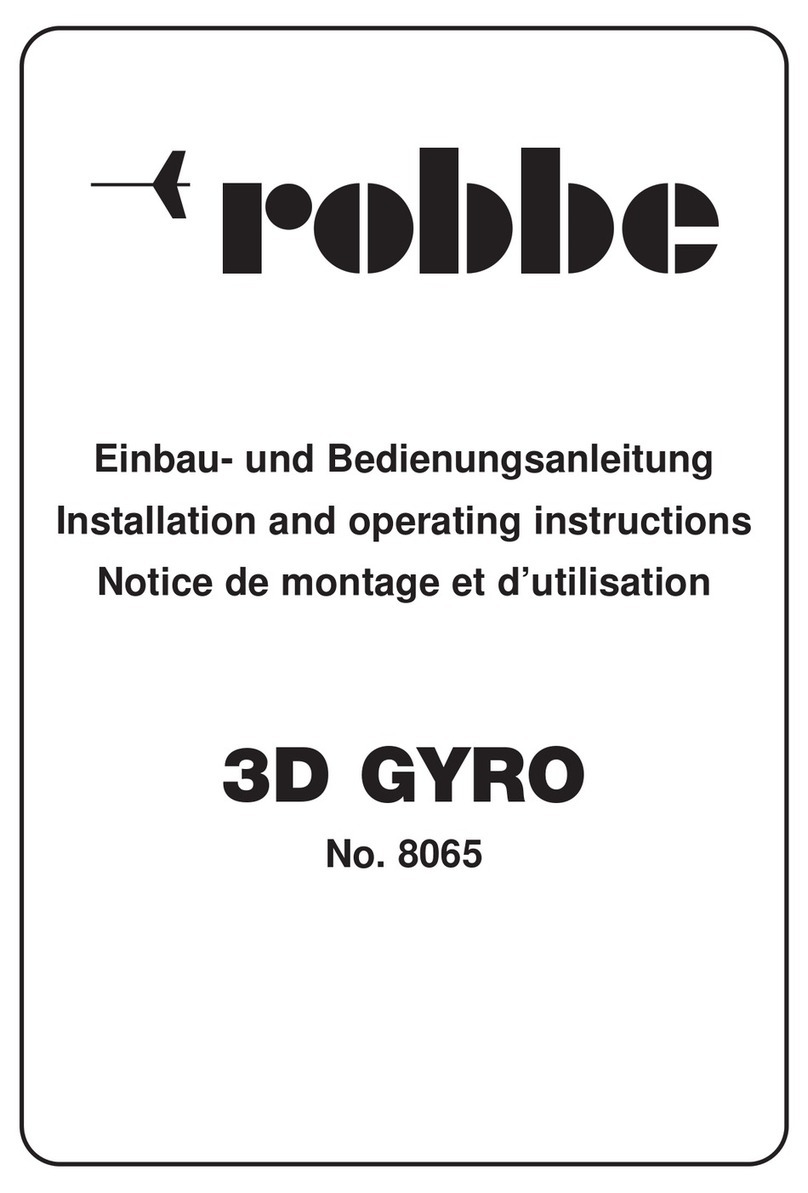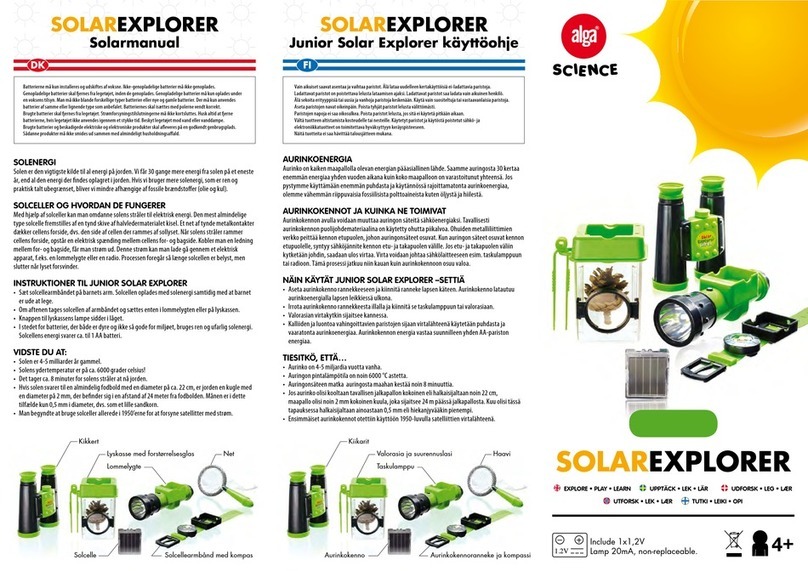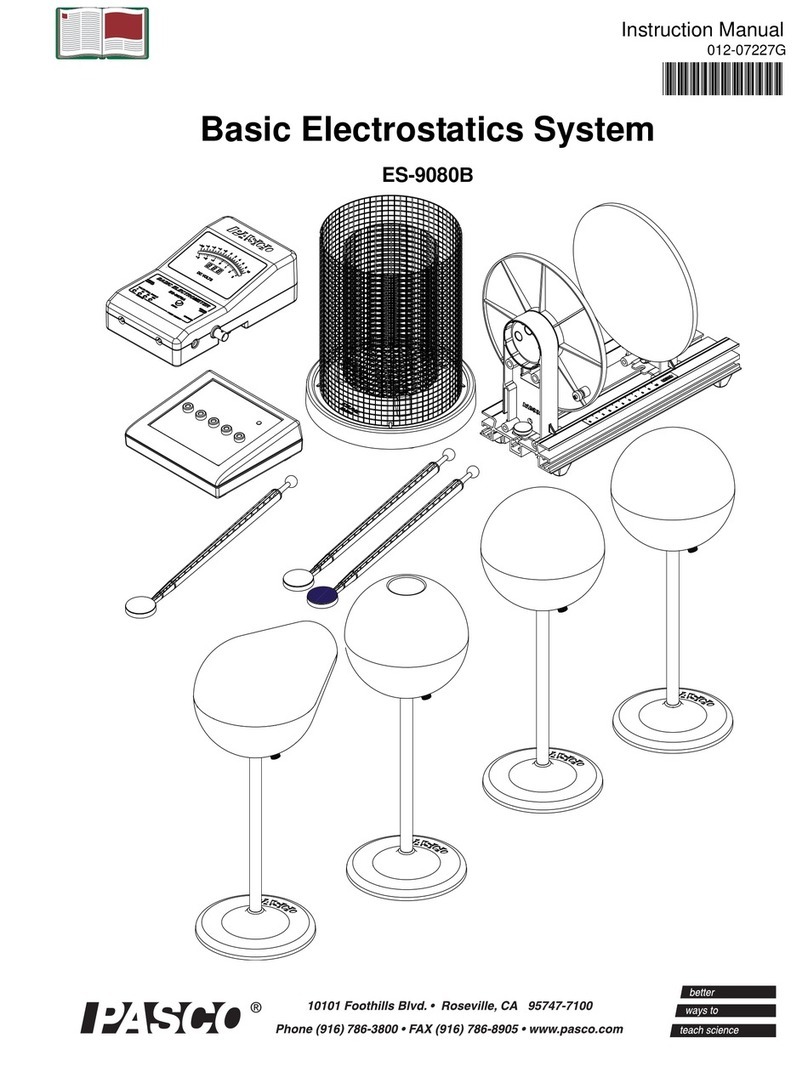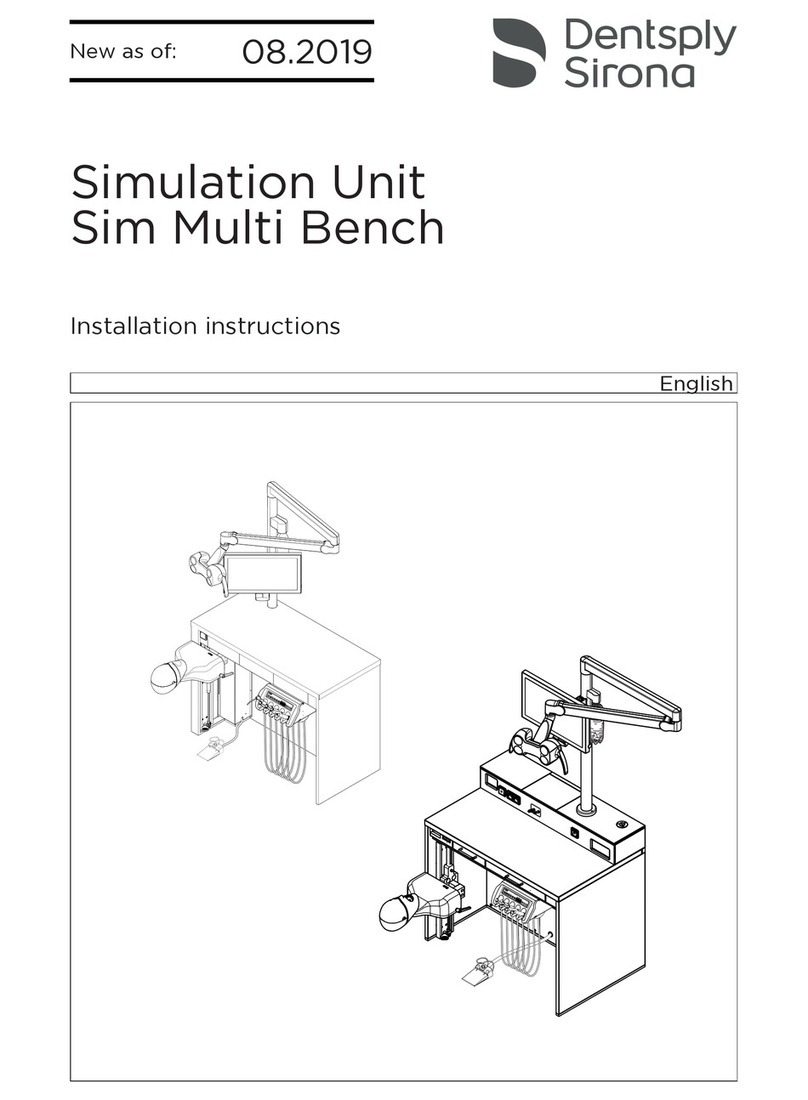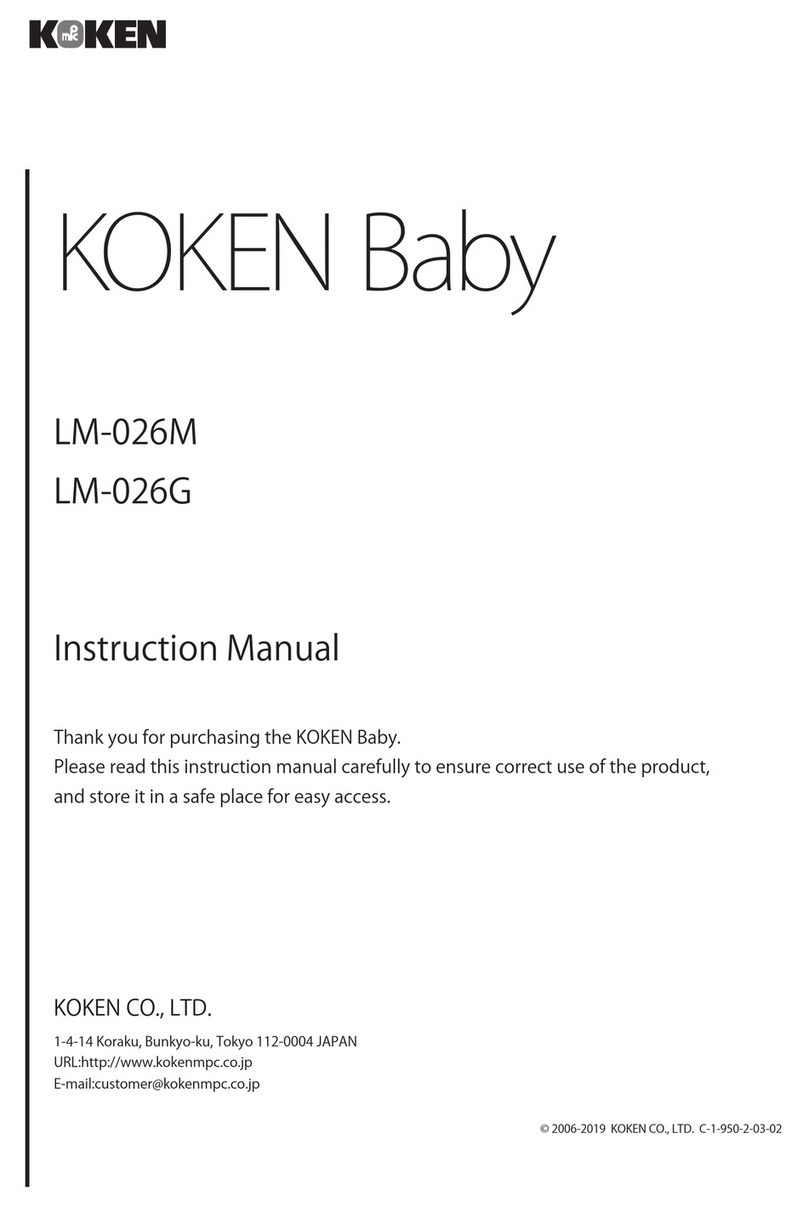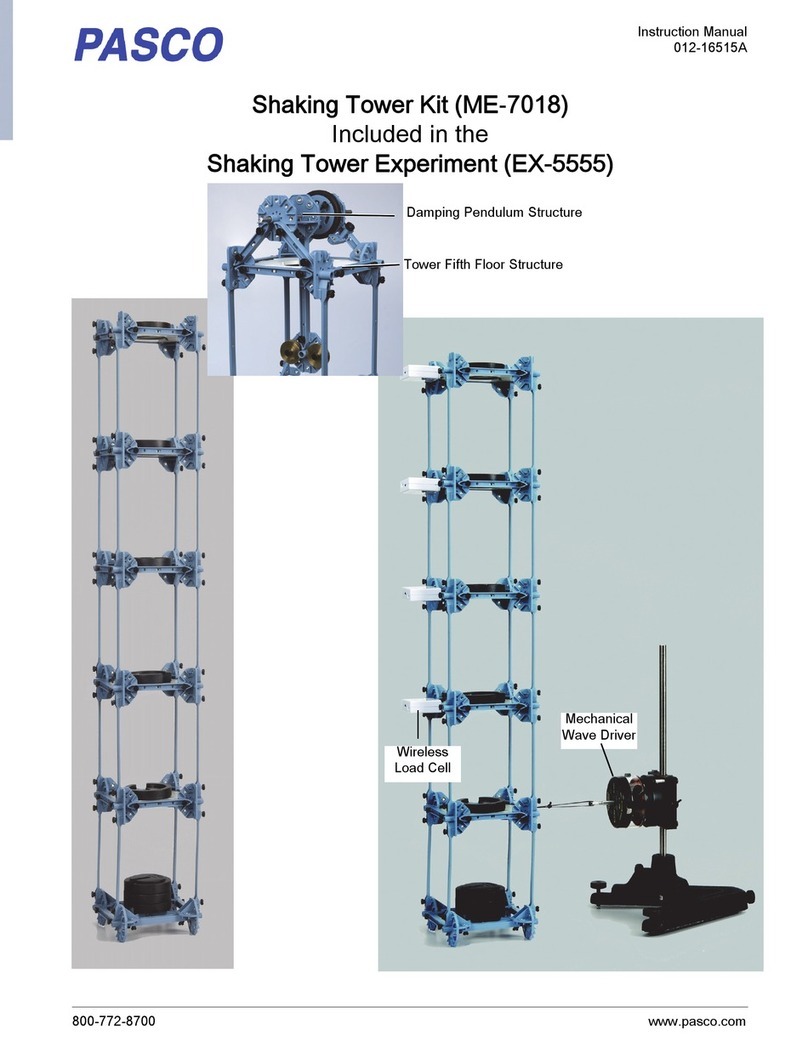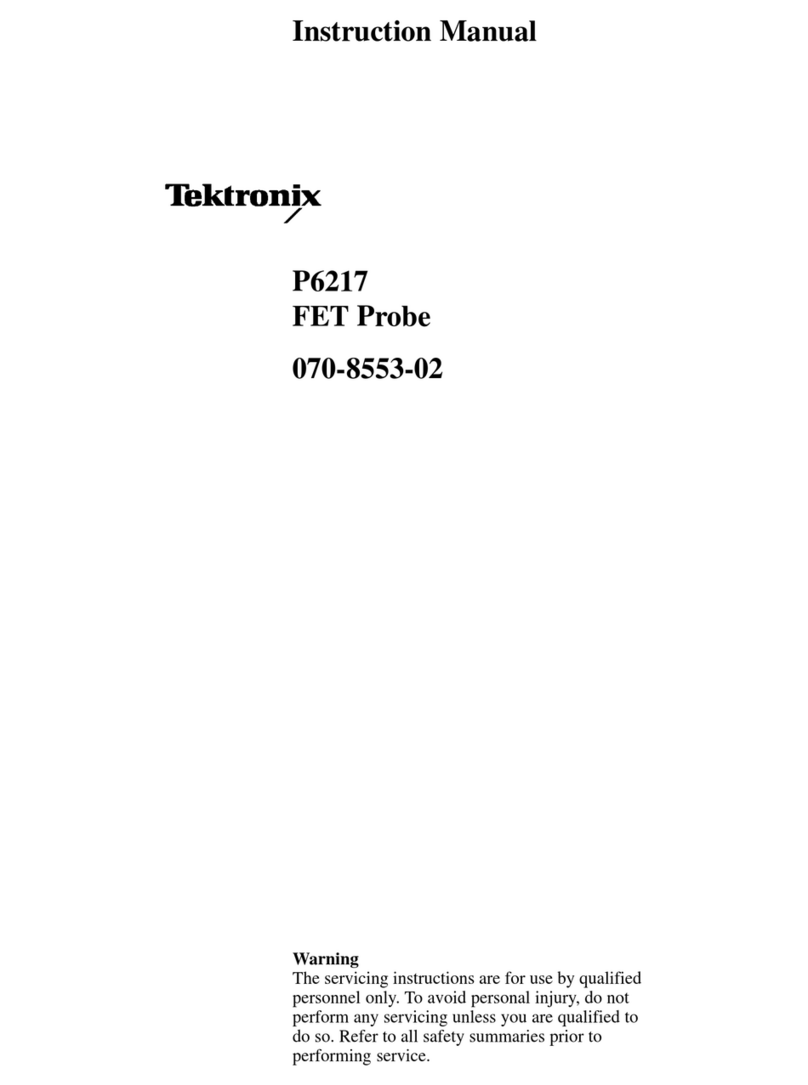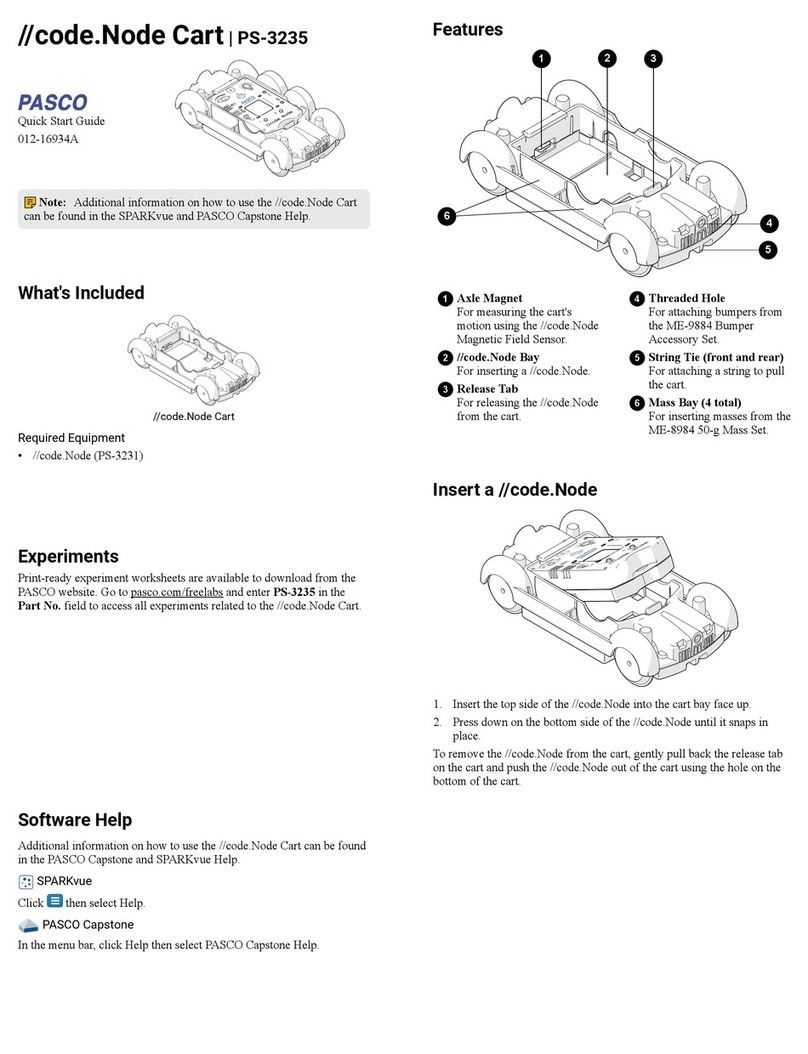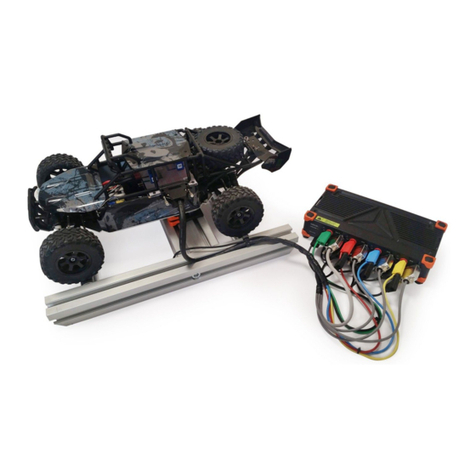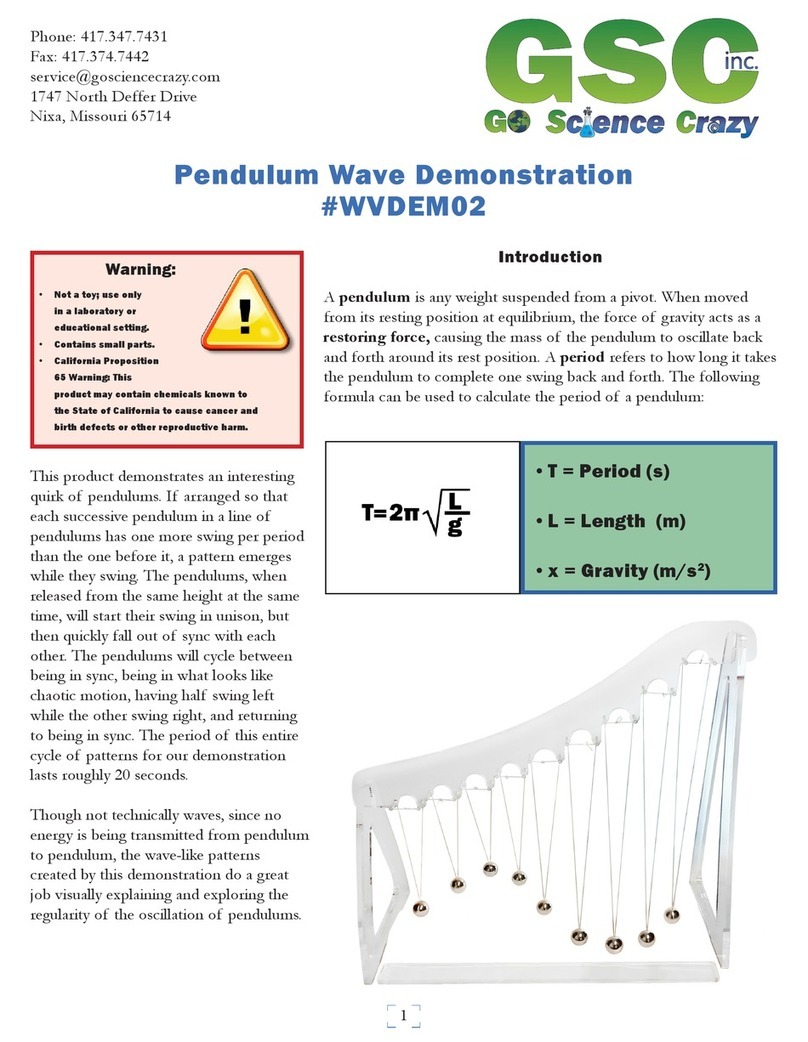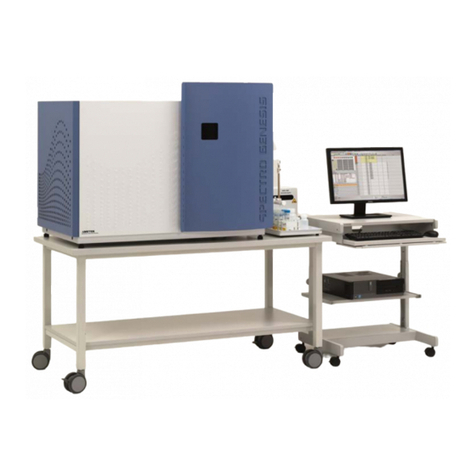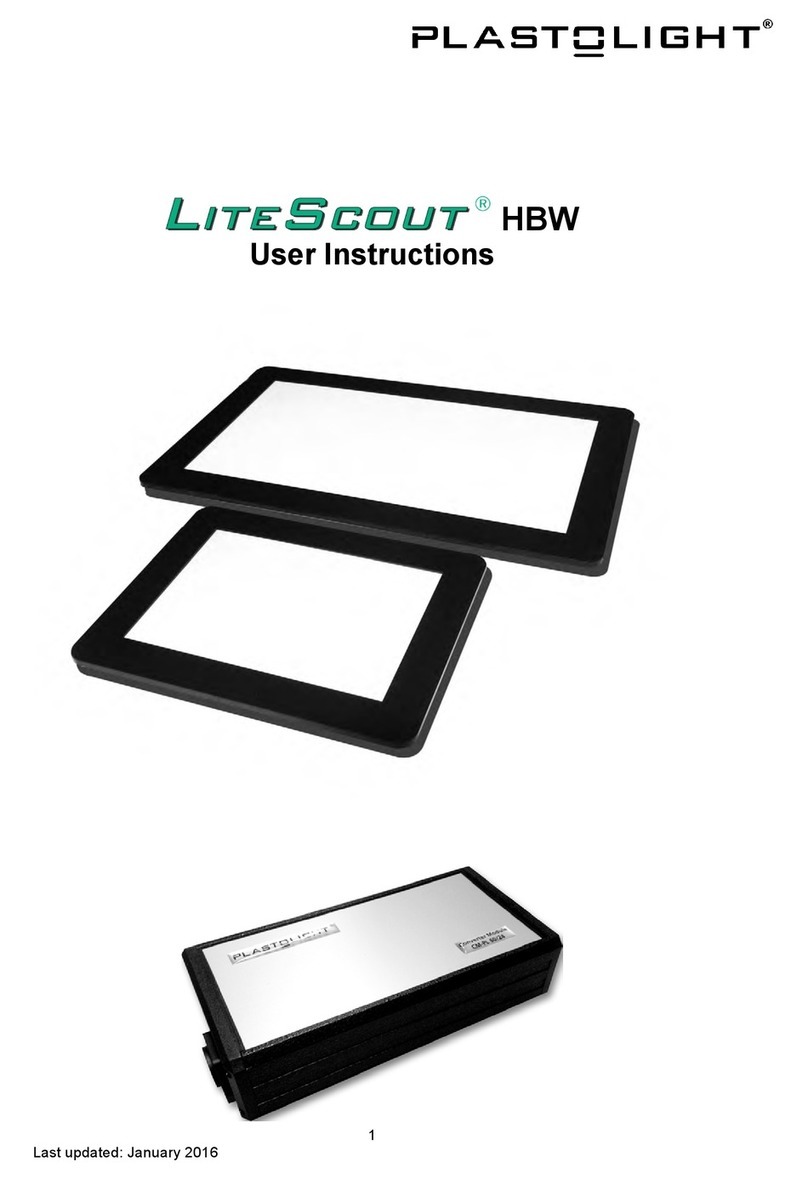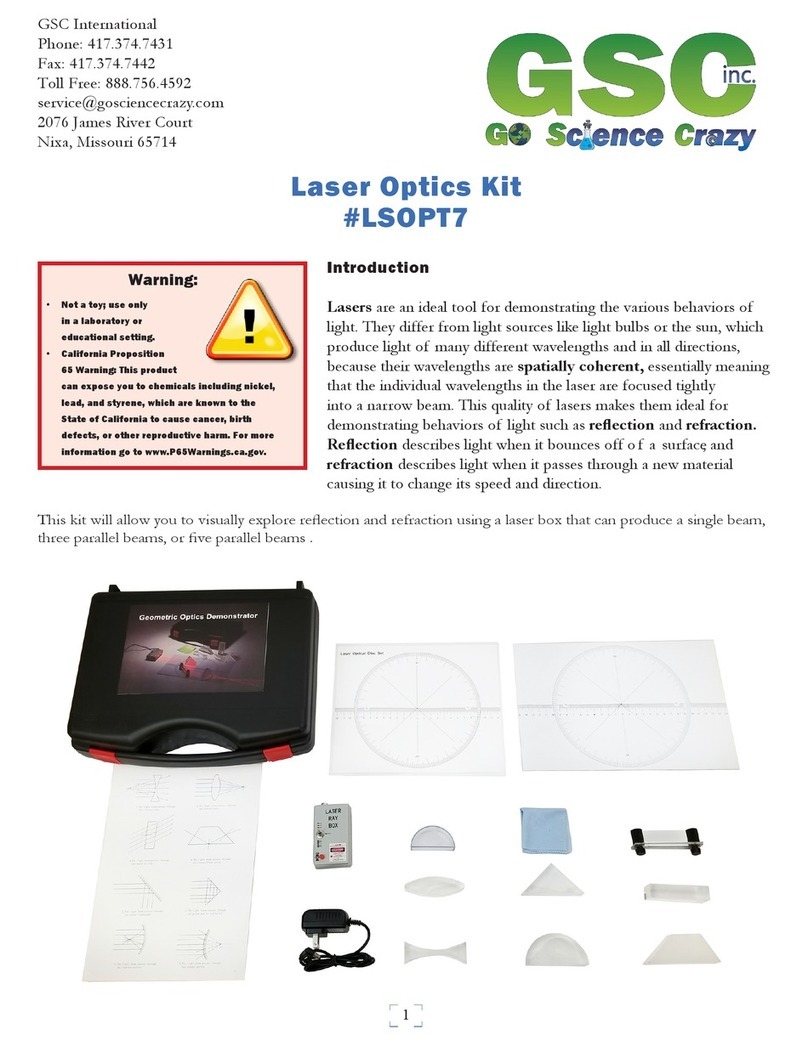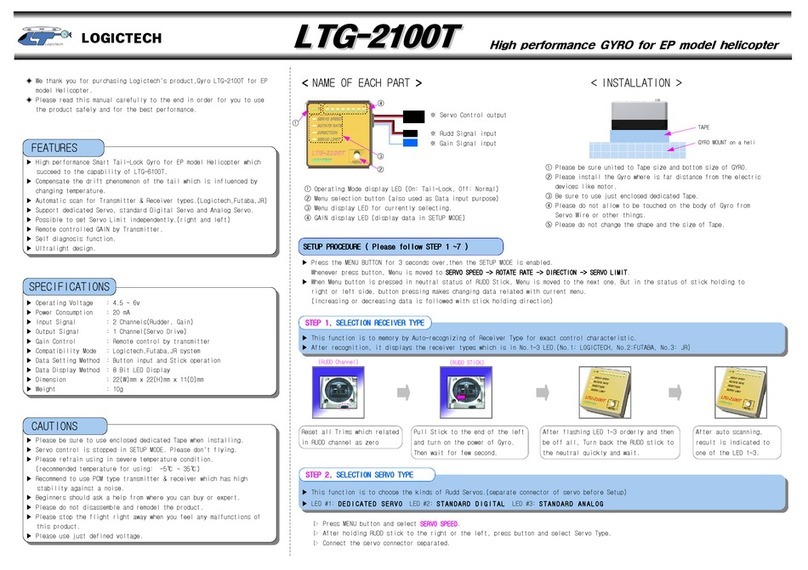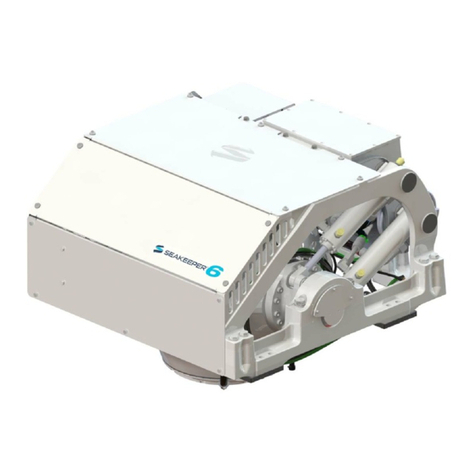ROBBE Piezo Gyro G 400 User manual

Einbau- und Bedienungsanleitung
Installation and operating instructions
Notice de montage et d’utilisation
No. 8067
Piezo Gyro G 400

No.
8067
3
Piezo Gyro G 400
Achtung: Neues Funktionsprinzip, Anleitung vor Inbetriebnahme des Gerätes unbedingt
lesen
1. Vorwort:
Der robbe Piezo Gyro G 400 ist ein revolutionäres Präzisions - Kreiselsystem mit Piezo -
Sensor für Flug- und Hubschraubermodelle.
Dieser moderne Piezo - Kreisel besitzt 2 unterschiedliche Modi:
Normaler Modus
In diesem Modus erfolgt die Stabilisierung einer Achse ( z.B. Heckrotor) wie bei bisherigen
Kreiselsystemen. Wird das Modell durch äußere Einflüsse wie Wind, schnelle
Drehzahländerung oder Pitchänderungen aus seiner Lage gebracht, so wird über den
Piezo - Sensor dieser Wert gemessen als Steuersignal umgeformt und dem Heckrotor -
Servo als Korrekturwert zugeführt, um die Differenz auszugleichen.
Heading Hold Modus
Heading Hold bedeutet soviel wie „Richtung halten“. In diesem Modus arbeitet der Piezo
Gyro G 400 zunächst wie ein normaler Kreisel, zusätzlich aber „merkt“ sich der Kreisel
seine derzeitige Lage. Wird das Modell nun um die Kreiselachse, durch äußere Einflüsse
wie Wind etc., aus seiner Lage gebracht, summiert die Elektronik diese Abweichungen auf
und steuert das Modell in seine ursprüngliche Lage zurück. Dieses Zurücksteuern erfolgt
so schnell, daß eine Auslenkung fast nicht zum Tragen kommt. Das Modell steht wie
„angenagelt“ in seiner gesteuerten Position. Völlig
gleich, ob quer zum Wind, Wind im Rücken, auf
dem Rücken etc.. Der Piezo Gyro G 400 versucht
unter allen Umständen diese Position beizubehal-
ten.
Hinweis:
Um die maximale Leistung zu erreichen, sollte der
Piezo Gyro G 400 in Verbindung mit einem sehr
schnellen Servo für die Heckrotorsteuerung betrie-
ben werden. Selbstverständlich können auch
Servos mit normaler Stellgeschwindigkeit einge-
setzt werden. Allerdings sind die
Stabilisierungsergebnisse dann nicht so perfekt wie
mit den superschnellen Servos.
Servoempfehlung:
Betrieb mit 4,8 Volt (4 NC, NiMH)
Servo S 9253 No. F 1278
Betrieb mit 6 Volt (5 NC, NiMH)
Servo S 9254 No. F 1266
Servos für Elektro-Klein-Hubschrauber:
S 3101, No. F 1258 oder FS 500 Micro BB, No. 8460.
3D
GYRO
Ready Rev Gain
Servo
Aux
Rx
Piezo Gyro with
Headling Hold
No. 8065
Made in Germany
1
2
3
4
5
6
7
8
Receiver
35 MHz
Ready Rev Gain
Servo
Aux
Rx
G-400
Normal and Heading Hold
Piezo-Gyro
No. 8067
Kan. 4
Kan. 5
Skizze 1
No.
8067
Piezo Gyro G 400
2
Inhaltsverzeichnis - Contents - Contenu résumé
Einbau und Bedienungsanleitung Piezo Gyro G 400 (deutsch) Seite 3 - 9
Installation and operating instructions Piezo Gyro G 400 (english) page 10 - 16
Notice de montage et d’utilisation Piezo Gyro G 400 (française) page 17 - 23
Für Ihre Notizen - Notes - Pour prendre des notes

No.
8067 No.
8067
4 5
Piezo Gyro G 400
3. Einbau
Wichtig: Alle Kreiselsysteme mit Piezo - Sensoren sind empfindlich gegen Vibrationen. In
einem vibrationsbelasteten Modell werden Sie mit keinem Piezo - Kreisel zufriedenstellen-
de Ergebnisse erzielen. Mit den beiliegenden Schaumstoffteilen können Sie das
Kreiselsystem auf Ihr Modell anpassen. Gute Ergebnisse wurden auch mit dem 3,2 mm
dicken Doppelklebeband von 3M (robbe Bestell - Nr. 5014) erzielt. Deshalb empfehlen wir
Ihnen dringend, diesem Punkt besondere Aufmerksamkeit zu schenken.
Kleben Sie einen der mitgelieferten selbstklebenden Schaumstoffstreifen auf die
Unterseite des Kreisel - Gehäuses. Plazieren Sie das Gehäuse nun an einer vibrationsar-
men Stelle im Modell (beim Futura z.B. im Dom unter dem Pitchservo). Der Kreisel ist so
einzubauen, daß die zu stabilisierende Achse senkrecht durch den Kreisel verläuft ( siehe
Skizze 3). Die Einbauposition ist unkritisch, ob in der Nähe der Rotorwelle oder am
Servovorbau, wichtig ist nur, daß der Piezo Gyro G 400 gegen Vibrationen gut geschützt
ist.
Ready RevGain
Servo
Aux
Rx
GYRO
ReadyRevGain
Servo
Aux
Rx
GYRO
ReadyRevGain
Servo
Aux
Rx
GYRO
Stabilisierung der Hochachse
Stabilisierung der Längsachse
Stabilisierung der Querachse
Skizze 3
Piezo Gyro G 400
2. Für ganz eilige, Kurzanleitung zur ersten Inbetriebnahme:
· Anschluß gemäß Skizze 1 vornehmen
· Sender einschalten
· Empfänger einschalten
· Modell bzw. Piezo Gyro G 400 ca. 10 Sekunden nicht bewegen, Piezo Gyro G 400
führt seinen Nullabgleich durch.
·Abgleich fertig -> Heckrotor - Servo läuft auf Ausgangsstellung und die rote LED
”Ready“ am Piezo Gyro G 400 leuchtet
· Schieberegler Kanal 5 in eine Endposition bringen
· Heckrotor - Steuerknüppel in eine Endstellung bringen und loslassen
· Geht das Servo wieder auf seine ursprüngliche Position zurück -> Normal Modus
· Bleibt das Servo an dieser Stelle stehen -> Heading Hold Modus
· Der Schieberegler 5 wirkt als „Umschalter“ zwischen den beiden Modi und gleichzei-
tig als Empfindlichkeitseinsteller.
Bei Mittelstellung: 0%
Bei Stellung Richtung: I 0% - 100% „Normal“ Modus
Bei Stellung Richtung: II 0% - 100% „Heading Hold“ Modus
LINEAR
100 %
0 %
100 %
Normal Modus
Heading Hold Modus
I
II
Skizze 2

No.
8067 No.
8067
6 7
Piezo Gyro G 400
· Kontrolle der Servo-Laufrichtung: Heckrotor Steuerknüppel nach rechts bewegen,
gehen die Vorderkanten der Heckrotorblätter nach links? Wenn nicht, Servo Reverse
am Sender durchführen.
· Kontrolle Wirkrichtung Kreisel (Schalter REV): Heckausleger nach rechts bewegen,
gehen die Vorderkanten der Heckrotorblätter nach links? Wenn nicht, den Schalter
„REV“ am Piezo Gyro G 400 umschalten. Hinweis: Umschaltung erfolgt erst nach
erneutem Aus / Einschalten des Kreisel (Angaben in Flugrichtung).
Nun kann über den Schieberegler 5, vom Sender aus die Empfindlichkeit stufenlos von
0 - 100 % eingestellt werden.
Hinweis: Im Gegensatz zu den bisherigen Kreiselsystemen wird beim Piezo Gyro G 400
mit der Kreiselempfindlichkeit auch der Servoweg reduziert, da bei geringerer
Kreiselempfindlichkeit auch ein kleinerer Heckrotorsteuerweg (bei gleicher Steuerfolgsam-
keit) benötigt wird. Der Kreisel besitzt zudem eine exponentielle Steuercharakteristik. Eine
Einstellung von unter 30 % ist nicht praxisgerecht und sollte nicht vorgenommen werden,
weil sich der Heckrotorsteuerweg deutlich reduziert.
Um sich beim 1. Flug an den Kreisel zu gewöhnen, empfehlen wir folgende
Grundeinstellwerte:
· Servowegeinstellung Heckrotor (ATV): ca. 70 %
· Kreiselempfindlichkeit (ATV): ca. 70 %
4.2. Anschluß und Abstimmung des Piezo Gyro G 400 für „Heading Hold Modus“ mit
Empfindlichkeitseinstellung am Sender
Wie bereits eingangs beschrieben, wird in diesem Modus sehr gut die Heckauslegerposi-
tion beibehalten. Dieser neue Modus bietet folgende Vorteile:
· Für den Einsteiger ergibt sich nun die Möglichkeit, sich völlig auf die anderen Grundfunk-
tionen des Hubschraubers zu konzentrieren. Denn das Heck steht immer in der einmal
eingestellten Position.
· Bei Übungen quer zum Wind braucht der Heckrotor nicht nachgesteuert werden. Das
Modell fliegt ohne Windfahneneffekt. Das heißt, der Heckausleger wird sich nicht in den
Wind drehen. Um „geradeaus zu fliegen“ ist es nun allerdings erforderlich mit leichten
Steuerknüppelkorrekturen den Hubschrauber in die gewünschte Position zu stellen.
· Ideal für das seit geraumer Zeit immer mehr in Mode kommende 3D Fliegen, bzw. rück
wärts Fliegen, da das Heck nicht nachgesteuert werden muß. Eine einmal gewählte
Richtung bleibt erhalten.
Wichtig:
· Der Piezo Gyro G 400 erkennt und korrigiert kleinste Abweichungen, so daß er keine
Unterstützung durch einen Pitch -> Heckrotor Mischer (Revo-Mix) benötigt. Der
Mischer muß ausgeschaltet werden.
· Um schnelle Pirouetten zu steuern, wurden bei herkömmlichen Kreiselsystemen die
Empfindlichkeit elektronisch ausgeblendet (Gyro-Sens-Mischer). Dies ist bei dem Piezo
Gyro G 400 nicht mehr erforderlich, denn hier wird das Sensorsignal vom
Steuerknüppel übersteuert. Wie stark es übersteuert wird legt man über die
Servowegreduzierung (ATV) fest. Deshalb muß der Ausblendmischer (Gyro-Sens)
unbedingt ausgeschaltet werden.
· Ebenfalls sind alle anderen Mischfunktionen die auf den Heckrotor wirken abzuschal-
ten. (z.B. Mischer Taumelscheibe -> Heckrotor)
Piezo Gyro G 400
4. Anschluß und Inbetriebnahme
Hinweis: Sobald der Aux-Kanal angeschlossen wird, ist der Regler Gain außer Funktion.
4.1. Anschluß und Abstimmung des Piezo Gyro G 400 für „ Normal Modus“ mit
Empfindlichkeitseinstellung vom Sender aus.
Stabilisierung des Heckrotors wie bei bisherigen Piezo Kreiselsystemen. Dieser Modus ist
geeignet für normales Fliegen, sowie zum Training von Kunstflugfiguren. Im Gegensatz, zu
dem später beschriebenen Heading Hold Modus, wird sich der Heckausleger des Modells
durch den Windfahneneffekt in den Wind drehen.
Wichtig:
· Der Piezo Gyro G 400 erkennt und korrigiert kleinste Abweichungen, so daß er keine
Unterstützung durch einen Pitch -> Heckrotor Mischer (Revo-Mix) benötigt, wir emp-
fehlen diesen Mischer auszuschalten.
· Um schnelle Pirouetten zu steuern, wurde bei herkömmlichen Kreiselsystemen die
Empfindlichkeit elektronisch ausgeblendet (Gyro-Sens-Mischer). Dies ist bei dem Piezo
Gyro G 400 nicht mehr erforderlich, denn hier wird das Sensorsignal vom
Steuerknüppel übersteuert. Wie stark es übersteuert wird, legt man über die
Servowegreduzierung (ATV) fest. Deshalb muß der Ausblendmischer (Gyro-Sens)
unbedingt ausgeschaltet werden.
· Ebenfalls sind alle anderen Mischfunktionen die auf den Heckrotor wirken abzuschal-
ten (z.B. Mischer Taumelscheibe -> Heckrotor)
Wie in der Skizze 1 gezeigt, den Piezo Gyro G 400 zwischen das Heckrotorservo und den
Empfänger stecken und den Anschluß „Aux“ an einen freien Schieberkanal ( z.B. Kanal 5 )
anschließen.
· Sender einschalten.
· Empfänger einschalten.
· Modell bzw. Piezo Gyro G 400 ca. 10 Sekunden nicht bewegen, Piezo Gyro G 400
führt Nullabgleich durch.
·Abgleich fertig -> Heckrotorservo läuft auf Ausgangsstellung und die rote LED
”Ready“ am Piezo Gyro G 400 leuchtet.
· Sollte das Modell trotzdem bewegt worden sein, oder die Kontroll - LED blinken, so
muß zur erneuten Initialisierung die Empfängerstromversorgung aus - und wieder ein-
geschaltet werden.
· Schieberegler Kanal 5 in eine Endposition bringen.
· Heckrotor - Steuerknüppel in eine Endstellung bringen und loslassen.
· Geht das Servo wieder auf seine ursprüngliche Position zurück -> Normal Modus.
· Bleibt das Servo stehen, so befindet sich der Kreisel im Heading Hold Modus, Schieber
5 auf entgegengesetzte Endposition bringen.
· Heckrotortrimmung in die Mitte stellen.
· Servohebel mechanisch so anbringen, daß der Arm nahezu 90° zum Gestänge steht.
· Gestänge am Heckgetriebe in das äußerste Loch einhängen.
· Heckrotor Steuerknüppel auf Vollausschlag stellen.
· Gestänge am Servohorn so einhängen, daß sich der maximale Steuerweg ergibt aber
kein mechanischer Anschlag am Heckrotor erfolgt.

No.
8067 No.
8067
8 9
Piezo Gyro G 400
5. Allgemeines
5.1 Modellvoraussetzungen
Durch die hohe Empfindlichkeit des Kreisels und das starke, schnell reagierende
Heckrotorservo und der damit verbundenen Reaktion des Heckrotors, wird das Heck deut-
lich mehr als üblich belastet. Dies erfordert einen torsionssteifen Heckrotorantrieb und ein
standfestes Heckrotorgetriebe. Es wird ein Starrantrieb empfohlen, um die höheren
Lastwechselreaktionen abzufangen. Des weiteren muß die Gestängeverbindung so spiel-
arm und leichtgängig wie möglich sein.
5.2 Temperaturanpassung
Obwohl das Kreiselsystem nach besten technischen Möglichkeiten temperaturkompen-
siert wurde, ist bei Temperaturdifferenzen zwischen Kreisel und Umgebung, eine
Anpassung erforderlich. Hierzu wird empfohlen, den Kreisel in eingeschaltetem Zustand
bis ca. 5 Minuten an die Umgebungstemperatur anzupassen. Danach erneut aus- und ein-
schalten.
5.3 Sonstige Hinweise:
· Bei RC-Anlagen mit flugzustandsabhängiger ATV- Einstellung, z.B. FC 28 kann für
jeden Flugzustand eine separate Heckrotor-Servoweg-(ATV) und Empfindlichkeitsein-
stellung vorgenommen werden, welche über die Flugzustandsschalter "Idle-Up 1",
"Idle-Up 2" automatisch mit umgeschaltet wird.
· Je nachdem, welche Haupt- und Heckrotorkombination verwendet wird, kann es dazu
führen, daß im Normal Modus der Heckausleger leicht schwingt. Dies ist nicht unbe-
dingt auf eine zu hohe Empfindlichkeitseinstellung zurückzuführen, sondern kann auch
von zu großen oder zu tiefen Heckrotorblättern herrühren. In diesem Fall die
Heckrotorblätter ca. 3 - 5mm kürzen.
· Die beim Einschalten des Kreisels eingelesene Konfiguration der Kanäle Heckrotor und
Aux sowie die Position des Rev-Schalters werden abgespeichert. Sofern die Stecker
”Aux“ bzw. ”Rx“ im Empfänger umgesteckt werden oder die Reversefunktion geändert
wird, ist es erforderlich den Kreisel aus - und einzuschalten damit die Konfiguration neu
eingelesen und abgespeichert wird.
6. Technische Daten:
Betriebsspannung: 3 - 8 Volt aus dem Empfängerakku
Stromaufnahme: ca. 25 mA (bei 4,8V)
Abmessungen: ca. 41 x 41 x 20 mm
Gewicht: ca. 30 g
7. Lieferumfang
1 x Piezo Gyro G 400
2 x 2 selbstklebende Dämpfungsschaumstoffstreifen
1 x Bedienungsanleitung
robbe Modellsport GmbH & Co. KG
Technische Änderungen vorbehalten
Piezo Gyro G 400
Zur Inbetriebnahme wie unter 4.1 beschrieben vorgehen.
· „Heading Hold“ Modus aktivieren (Schieberkanal 5 auf Anschlag).
· Auf den Heckrotor achten, je nach Neutralimpuls der Fernsteuerung läuft er in eine
Richtung weg.
· Über die Trimmung kompensieren, bis der Heckrotor bzw. das Servo stehen bleibt (TIP:
wenn möglich die Trimmung elektronisch reduzieren (z.B. TRIM RATE 30 - 40 %) um
feinfühliger justieren zu können.
· „Normal“ Modus aktivieren.
· Modell in den Schwebeflug bringen, Nase in den Wind drehen.
· Wenn sich das Modell im Schwebeflug um die Hochachse wegdreht, landen und das
Heckgestänge - nicht die Trimmung - nachjustieren.
· Diesen Vorgang ggf. mehrmals wiederholen.
· Wenn das Modell nun um die Hochachse nicht mehr wegdreht, ist die mechanische
und die elektronische Seite des Modells aufeinander angepaßt.
Nun kann im „Normal“ bzw. „Heading Hold“ Modus zum Rundflug gestartet werden. Alle
weiteren Einstellungen wie die maximale Kreiselempfindlichkeit und die Servowegeinstell
ung für den Heckrotor (ATV) (max. Drehgeschwindigkeit) müssen erflogen werden!
· Über den Schieberegler (z.B. Kanal 5), kann vom Sender aus die Empfindlichkeit stu-
felos von 0 - 100 % eingestellt werden.
Hinweis: Im Gegensatz zu den bisherigen Kreiselsystemen wird beim Piezo Gyro G 400
mit der Kreiselempfindlichkeit auch der Servoweg reduziert, da bei geringerer
Kreiselempfindlichkeit auch ein kleinerer Heckrotorsteuerweg (bei gleicher
Steuerfolgsamkeit) benötigt wird. Der Kreisel besitzt zudem eine exponentielle
Steuercharakteristik. Eine Einstellung von unter 30 % ist nicht praxisgerecht und sollte
nicht vorgenommen werden, weil sich der Heckrotorsteuerweg deutlich reduziert.
4.3. Anschluß des Piezo Gyro G 400 im „Normal Modus“ mit manueller
Empfindlichkeitseinstellung am Kreisel.
Bei Fernsteueranlagen mit geringer Kanalzahl, steht häufig kein freier Kanal zur Einstellung
der Kreiselempfindlichkeit zur Verfügung. In diesem Falle den Anschluß „Aux“ des Kreisels
nicht anschließen. Nun kann über den im Kreisel befindlichen Regler ”Gain“ die
Empfindlichkeit stufenlos von 0 - 100 % eingestellt werden, wobei im Uhrzeigersinn die
Empfindlichkeit erhöht und entgegengesetzt verringert wird.
Hinweis: Im Gegensatz zu den bisherigen Kreiselsystemen wird beim Piezo Gyro G 400
mit der Kreiselempfindlichkeit auch der Servoweg reduziert, da bei geringerer
Kreiselempfindlichkeit auch ein kleinerer Heckrotorsteuerweg (bei gleicher Steuerfolgsam-
keit) benötigt wird. Der Kreisel besitzt zudem eine exponentielle Steuercharakteristik. Eine
Einstellung von unter 30 % ist nicht praxisgerecht und sollte nicht vorgenommen werden,
weil sich der Heckrotorsteuerweg deutlich reduziert.
Wie in der Skizze 1 gezeigt, den Piezo Gyro G 400 zwischen das Heckrotorservo und den
Empfänger stecken. Der Anschlußstecker „Aux“ bleibt in dieser Anschlußvariante frei.
Wenn der Zusatzkanal nicht über die Fernsteuerung angeschlossen werden kann, arbeitet
der Kreisel automatisch im Normal Modus.
Der Heading Hold Modus kann dann nicht aktiviert werden.

No.
8067
11
No.
8067
10
Piezo Gyro G 400
2. If you are in a real hurry, here are brief instructions for getting the gyro working:
· Connect the system as shown in Sketch 1
· Switch on the transmitter
· Switch on the receiver
· Do not touch the model or Piezo Gyro G 400 for about 10 seconds while the Piezo
Gyro G 400 carries out its zero calibration procedure.
·When ready -> tail rotor servo runs to starting position and the red „Ready“ LED on
the Piezo Gyro G 400 lights up
· Move channel 5 slider to one end-point
· Move tail rotor stick to one end-point and release it
· If servo moves back to its original position -> Normal mode
· If servo stays in the end-point position -> Heading Hold mode
· Slider 5 acts as change-over switch between the two modes, and is also used to adjust
gyro gain (sensitivity).
At centre position: 0%
At position direction: I 0% - 100% „Normal“ mode
At position direction: II 0% - 100% „Heading Hold“ mode
LINEAR
100 %
0 %
100 %
Normal Modus
Heading Hold Modus
I
II
Sketch 2
Piezo Gyro G 400
Caution: This gyro operates on a new principle. Please be sure to read the instructions
before using the system for the first time.
1. Foreword:
The robbe Piezo Gyro G 400 is a precision gyro system of revolutionary design based on
a piezo sensor, and is suitable for fixed-wing model aircraft and helicopters.
This modern piezo-gyro provides two different modes of operation:
Normal mode
In this mode the gyro stabilises the aircraft around one major axis (e.g. tail rotor), as with
earlier types of gyro system. If an external influence such as a gust of wind, or a rapid
change in rotational speed or collective pitch pushes the model out of its intended positi-
on, then the piezo-sensor picks up and measures the change, converts it into a compen-
satory signal and passes it to the tail rotor servo which then carries out the necessary cor-
rective action.
Heading Hold mode
Heading Hold means „maintaining direction“. In this mode the Piezo Gyro G 400 works pri-
marily as a conventional gyro, but at the same time the unit „remembers“ the current posi-
tion of the model. If it is then pushed out of position around the gyro axis by an external
influence such as wind etc., the electronic circuitry calculates the total deviation and cau-
ses the tail rotor to move the model back into its original position. In practice this process
of returning the helicopter to its original position is
completed so quickly that the deviation hardly
seems to occur at all. The model stays rock-solid in
its intended position as if „nailed“ to the sky.
Moreover this is true without any regard of the
model’s attitude, i.e. if its heading is cross-wind, or
with a tail-wind, or even if it is inverted, under all cir-
cumstances the Piezo Gyro G 400 attempts to main-
tain this position.
Note:
If you wish to achieve maximum performance the
Piezo Gyro G 400 should always be operated in con-
junction with a very fast tail rotor servo. Of course,
servos of normal transit speed can still be used, but
the stabilisation effect will not be quite as perfect as
with a super-fast servo.
Recommended servos:
4.8 Volt power supply (4 NC, Ni-MH)
S 9253 servo Order No. F 1278
6 Volt power supply (5 NC, Ni-MH)
S 9254 servo Order No. F 1266
Servos for small electric helicopters:
S 3101,Order No. F 1258 or FS 500 Micro BB, Order No. 8460.
3D
GYRO
Ready Rev Gain
Servo
Aux
Rx
Piezo Gyro with
Headling Hold
No. 8065
Made in Germany
1
2
3
4
5
6
7
8
Receiver
35 MHz
Ready Rev Gain
Servo
Aux
Rx
G-400
Normal and Heading Hold
Piezo-Gyro
No. 8067
Ch. 4
Ch. 5
Sketch 1
Normal mode
Heading Hold mode

No.
8067 No.
8067
12 13
3. Installation
Important: all gyro systems based on piezo sensors are vulnerable to vibration, and if your
model suffers from excessive vibration you will not obtain satisfactory results with any
piezo-gyro. However, you can be sure of obtaining good results by mounting the gyro unit
in your model using the foam plastic damper pads supplied. We also recommend the 3.2
mm thick double-sided foam tape made by 3M (robbe Order No. 5014). To avoid disap-
pointment we strongly recommend that you pay particular attention to the elimination of
vibration in your model.
Apply one of the self-adhesive foam strips to the underside of the gyro case. Install the
case in a low-vibration location in the model (e.g. in the dome under the collective pitch
servo of a Futura). The gyro must be orientated in such a way that the axis to be stabilised
runs vertically through the gyro (see Sketch 3). The installation position is non-critical, and
can be close to the rotor shaft or in the front servo structure. The only really important point
is that the Piezo Gyro G 400 is well protected from vibration.
Piezo Gyro G 400
4. Connecting the gyro system, using the system for the first time
Note: The manual „gain“ adjustor is switched out of circuit if you connect the Aux chan-
nel to the receiver.
4.1. Connecting the Piezo Gyro G 400 and setting it up for „Normal“ mode with gyro
gain control from the transmitter
In this mode the tail rotor is stabilised in the same way as with a conventional piezo-gyro
system. This mode is suitable for normal flying and aerobatic practice. In contrast to
Heading Hold mode (described later), the tail boom of the model will be affected by the
wind and will tend to „weathercock“.
Important:
· The Piezo Gyro G 400 detects and corrects the tiniest of deviations, which means that
it does not require assistance from a collective pitch -> tail rotor mixer (Revo-Mix). We
recommend that you switch this mixer off.
· Conventional gyro systems usually feature electronic gyro suppression (Gyro-Sens.-
Mixer) which allows the model to fly high-speed pirouettes. This is not required with the
Piezo Gyro G 400, since the sensor signal is always over-ridden by any stick command.
The extent to which it is over-ridden is determined by the servo travel setting (ATV). For
this reason the suppression mixer (Gyro-Sens.) must always be switched out of circuit
when the Piezo Gyro G 400 is in use.
· For the same reasons all the other mixer functions which affect the tail rotor (e.g.
swash-plate -> tail rotor mixer) should also be switched off.
Connect the Piezo Gyro G 400 between the tail rotor servo and the receiver as shown in
Sketch 1, and connect the „Aux“ connector to a vacant slider channel (e.g. Channel 5).
· Switch on the transmitter.
· Switch on the receiver.
· Leave the model and the Piezo Gyro G 400 untouched for about 10 seconds while
the Piezo Gyro G 400 carries out its zero calibration process.
·Process complete -> tail rotor servo runs to starting position, red „Ready“ LED on
Piezo Gyro G 400 lights up.
· If you move the model too soon, or the monitor LED flashes, you must re-initialise the
gyro by switching the receiver power supply off and then on again.
· Move the channel 5 slider to one end-point.
· Move the tail rotor stick to one end-point and release it.
· If the servo runs back to its original position, the gyro is in -> Normal mode.
· If the servo stays in the „end-point“ position, the gyro is in Heading Hold mode. Move
slider 5 to the opposite end-point.
· Set the tail rotor trim to centre.
· Fit the output arm on the tail rotor servo in such a way that the arm is exactly at 90° to
the pushrod (or as close as possible to 90°).
· Connect the pushrod to the outermost hole at the tail rotor gearbox.
· Move the tail rotor stick to full travel.
· Connect the pushrod to one of the outer holes in the servo output arm. Aim for maxi-
mum linear pushrod movement, with the proviso that the linkage must not stall the
servo (mechanical obstruction) at full travel.
· Check the direction of servo travel. Move the tail rotor stick to the right and watch the
ReadyRevGain
Servo
Aux
Rx
GYRO
ReadyRevGain
Servo
Aux
Rx
GYRO
ReadyRevGain
Servo
Aux
Rx
GYRO
Piezo Gyro G 400
Stabilisation of the vertical axis
Stabilisation of the longitudinal axis
Stabilisation of the lateral axis
Sketch 3

No.
8067
15
No.
8067
14
Piezo Gyro G 400
To use the system follow the procedure as described under 4.1.
· Activate „Heading Hold“ mode (slider 5 to the appropriate end-point).
· Watch the tail rotor: it will tend to swing away in one direction in response to minor dif-
ferences in the radio control system’s neutral signal.
· Adjust the tail rotor trim until the tail rotor and the servo are stationary (TIP: if possible
reduce the trim travel electronically (e.g. TRIM RATE 30 - 40%) to provide finer control
of the neutral setting.
· Activate „Normal“ mode.
· Set the model to hover and turn the nose into wind.
· If the model swings around the vertical axis at the hover, land and adjust the tail rotor
linkage - but don’t move the trim.
· You may need to repeat this procedure several times.
· Once the model hovers without any natural tendency to swing, the model’s mechani-
cal system is correctly adjusted in relation to the electronic system.
Now you can try a circuit using „Normal“ or „Heading Hold“ mode. All further adjustments
such as maximum gyro gain and the optimum travel setting for the tail rotor servo (ATV)
(max. yaw rate) must be found during the test flying procedure.
· You can now adjust the sensitivity (gain) of the gyro from the transmitter. Slider 5 pro-
vides proportional control over the range 0 - 100%.
Note: In contrast to previous gyro systems, any reduction in the gain of the Piezo Gyro G
400 simultaneously reduces servo travel, since lower gyro sensitivity calls for less tail rotor
travel in order to obtain the same control response. The gyro also features an exponential
control characteristic curve. Values below 30% are not of practical usefulness and should
not be set in any case because they would reduce the tail rotor control travel to a dange-
rous extent.
4.3. Connecting the Piezo Gyro G 400 in „Normal mode“ with manual gain adjustment
on the gyro
If your radio control system has relatively few channels you may well find that no vacant
channel is available for remote gyro gain adjustment. If this is the case simply leave the
„Aux“ connector (attached to the gyro) unconnected. Gyro sensitivity can now be adjusted
proportionally within the range 0 - 100 % by rotating the adjustor marked „Gain“ on the
gyro. Turn it clockwise to increase gain, and anti-clockwise to reduce it.
Note: In contrast to previous gyro systems, any reduction in the gain of the Piezo Gyro G
400 simultaneously reduces servo travel, since lower gyro sensitivity calls for less tail rotor
travel in order to obtain the same control response. The gyro also features an exponential
control characteristic curve. Values below 30% are not of practical usefulness and should
not be set in any case because they would reduce the tail rotor control travel to a dange-
rous extent.
Connect the Piezo Gyro G 400 between the tail rotor servo and the receiver as shown in
Sketch 1. In this variant the connector marked „Aux“ is not connected. If the auxiliary
channel is not connected to the radio control system, the gyro automatically works in
Normal mode.
In this case it is not possible to activate Heading Hold mode.
Piezo Gyro G 400
tail rotor: The leading edge of the tail rotor blades should now move to the left; if not,
reverse the tail rotor servo at the transmitter.
· Check the direction of operation of the gyro (REV switch). Swing the tail boom to the
right: the leading edge of the tail rotor blades should now move to the left. If not, ope-
rate the „REV“ switch on the Piezo Gyro G 400. Note: if you use the „REV“ switch on
the gyro the change will not take effect until you switch the gyro off and then on again.
All stated directions are as seen from the tail of the model looking forward.
You can now adjust the sensitivity (gain) of the gyro from the transmitter. Slider 5 provides
proportional control over the range 0 - 100%.
Note: In contrast to previous gyro systems, any reduction in the gain of the Piezo Gyro G
400 simultaneously reduces servo travel, since lower gyro sensitivity calls for less tail rotor
travel in order to obtain the same control response. The gyro also features an exponential
control characteristic curve. Values below 30% are not of practical usefulness and should
not be set in any case because they would reduce the tail rotor control travel to a dange-
rous extent.
For initial familiarisation flights with the new gyro we suggest the following basic set-
tings:
· Tail rotor servo travel (ATV): approx. 70%
· Gyro gain (ATV): approx. 70%
4.2. Connecting and setting up the Piezo Gyro G 400 for „Heading Hold“ mode with
gain adjustment from the transmitter
As already described, the gyro very effectively maintains the helicopter’s tail boom positi-
on when in Heading Hold mode. The new mode offers the following advantages:
· The beginner now has the chance to concentrate completely on the other basic func-
tions of the helicopter, because the tail always stays in the same position.
· When practising cross-wind flying the tail rotor requires no control commands. The
model flies on a stable heading, with none of the usual weathercocking effect, i.e. the
tail boom has no tendency to turn under the influence of the wind. Admittedly this also
means that, in order to fly straight ahead, it is now necessary to use a slight stick
deflection to place the helicopter on the desired heading.
· This mode is ideal for the 3D style of flying which has been gaining ground steadily over
the past few years, since the tail does not need to be controlled separately when the
helicopter is flying backwards. Once set, the helicopter’s directional heading is main-
tained very effectively.
Important:
· The Piezo Gyro G 400 detects and corrects the tiniest of deviations, which means that
it does not require assistance from a collective pitch -> tail rotor mixer (Revo-Mix). We
recommend that you switch this mixer off.
· Conventional gyro systems usually feature electronic gyro suppression (Gyro-Sens.-
Mixer) which allows the model to fly high-speed pirouettes. This is not required with the
Piezo Gyro G 400, since the sensor signal is always over-ridden by any stick command.
The extent to which it is over-ridden is determined by the servo travel setting (ATV). For
this reason the suppression mixer (Gyro-Sens.) must always be switched out of circuit
when the Piezo Gyro G 400 is in use.
· For the same reasons all the other mixer functions which affect the tail rotor (e.g.
swashplate -> tail rotor mixer) should also be switched off.

No.
8067 Piezo Gyro G 400 No.
8067
16 17
Attention: Nouveau principe de fonctionnement, lire impérativement le mode d’emploi
avant de mettre l’appareil en service.
1. Préface
Le gyroscope piézo G 400 est un système gyroscopique révolutionnaire de précision pour
le pilotage de modèles réduits d’avions, de planeurs et d’hélicoptères avec capteur piézo.
Ce gyroscope piézo moderne dispose de deux modes de service différents:
Mode normal
Avec ce mode, la stabilisation intervient sur un axe (par exemple le rotor arrière), comme
pour les gyroscopes communs. Lorsque le modèle est tiré de son assiette de vol par des
incidences externes telles que le vent, une modification rapide du régime ou des change-
ments de pas, le capteur piézo mesure cette valeur, la transforme en signal et la commu-
nique au servo du rotor arrière comme valeur correctrice, afin de compenser la différence
apparue;
Mode tenue de cap
Tenue de cap signifie tenue de cap. Dans ce mode, le gyroscope piézo G 400 travaille
initialement comme un gyroscope normal, en plus toutefois, il „repère“ son assiette actu-
elle. Lorsque le modèle est tiré de son assiette de vol au niveau de l’axe dont se charge le
gyroscope, par des incidences externes telles que le vent, etc., l’électronique totalise ces
écarts et ramène le modèle à son assiette initiale. Cet instruction de retour à l’assiette
initiale est exécutée si rapidement qu’elle n’est pra-
tiquement pas assimilée par le pilote. Le modèle
semble „cloué“ à sa position, qu’il se trouve de tra-
vers par rapport au vent, face à lui ou avec vent
arrière, le gyroscope piézo G 400 s’efforce, quelles
que soient les circonstances de conserver la positi-
on.
À noter
Pour atteindre sa puissance maximale, il faut que le
gyroscope piézo G 400 soit associé à un servo extrê-
mement rapide pour le rotor arrière. Il est naturelle-
ment possible de l’exploiter également avec des ser-
vos à vitesse de positionnement normale. Toutefois
les effets de stabilisation ne seront alors pas aussi
rapides qu’avec un servo super rapide.
Servos recommandés
Alimenté par 4,8 volts (4 éléments Cd-Ni, Ni-MH):
servo S 9253 réf. F 1278
Alimenté par 6 volts (5 éléments Cd-Ni, Ni-MH):
servo S 9254 réf. F 1266
Servos pour petits hélicoptères électriques:
S 3101, réf. F 1258 ou FS 500 Micro BB, réf. 8460.
3D
GYRO
Ready Rev Gain
Servo
Aux
Rx
Piezo Gyro with
Headling Hold
No. 8065
Made in Germany
1
2
3
4
5
6
7
8
Receiver
35 MHz
Ready Rev Gain
Servo
Aux
Rx
G-400
Normal and Heading Hold
Piezo-Gyro
No. 8067
voie 4
schéma 1
Piezo Gyro G 400
5. General information
5.1 Model requirements
The high sensitivity of the gyro, the powerful response of the tail rotor and the high speed
with which the tail rotor reacts combine to place much higher loads than usual on the tail
of the model helicopter. This in turn requires a torsionally rigid tail rotor drive system and
a strong tail rotor gearbox. We recommend rigid drive systems, as they are better able to
absorb the forces exerted by the rapid changes in load. The mechanical linkage to the tail
rotor must also be as free-moving and direct (minimum slop) as possible.
5.2 Temperature adjustment
Although the gyro system is temperature-compensated as far as possible using the cur-
rently available solutions, it is still necessary for the gyro to be allowed to adjust itself to
the ambient temperature. For best results we recommend that you leave the gyro switched
on for about 5 minutes at the start of a flying session so that it can adjust to the surroun-
ding temperature. After this period switch the system off and then on again.
5.3 Supplementary notes
· If you are using an RC system with flight mode dependent ATV, e.g. an FC 28, you can
set tail rotor servo travel (ATV) and gyro gain separately for each flight mode, and these
settings can then be called up automatically when you operate the flight mode swit-
ches „Idle-Up 1“ and „Idle-Up 2“.
· Depending on the combination of main and tail rotor you are using, you may find that
the tail boom oscillates (swings from side to side) slightly in Normal mode. This may be
due to an excessively high gyro gain setting, but it can also be the result of tail rotor
blades which are too long or too wide. In this case the solution is to shorten the tail
rotor blades by about 3 - 5 mm.
· When the gyro is switched on it detects and stores the configuration of the tail rotor
and Aux channels and the position of the REV switch. If you ever need to connect the
„Aux“ and „Rx“ plugs to different receiver sockets, or if you use the reverse function, it
is then necessary to switch the gyro off and on again so that it can read in the new con-
figuration and store it.
6. Specification:
Operating voltage: 3 - 8 Volts, from receiver battery
Current drain: approx. 25 mA (at 4.8 V)
Dimensions: approx. 41 x 41 x 20 mm
Weight: approx. 30 g
7. Contents of set
1 x Piezo Gyro G 400
2 x 2 self-adhesive strips of damping foam
1 x operating instructions
robbe Modellsport GmbH & Co. KG
We reserve the right to alter technical specifications
voie 5

No.
8067
Piezo Gyro G 400 Piezo Gyro G 400 No.
8067
18 19
2. Notice abrégée pour les pilotes très pressés avant la première mise en service
· réaliser le raccordement selon les indications du schéma 1
· mettre l’émetteur en marche
· mettre le récepteur en marche
·ne pas déplacer le modèle ni le gyroscope piézo G 400 pendant approx. 10 secon-
des, le gyroscope piézo G 400 réalise un calibrage à zéro
·calibrage achevé -> le servo du rotor arrière se déplace en position initiale et la LED
rouge “Ready“ du gyroscope piézo G 400 s’allume
· amener le curseur de la voie 5 en fin de course
· amener le manche du rotor arrière dans une de ses fins de course et le relâcher
· lorsque le servo revient à sa position initiale -> mode normal
· lorsque le servo demeure dans sa position -> mode tenue de cap
· le curseur 5 fait office de „commutateur“ entre les deux modes et simultanément de
dispositif de réglage de la sensibilité.
en position médiane: 0%
en fin de course I. direction: 0% - 100% mode „normal“
en fin de course II. direction: 0% - 100% mode „tenue de cap“
LINEAR
100 %
0 %
100 %
Normal Modus
Heading Hold Modus
I
II
schéma 2
3. Mise en place
Important: tous les systèmes gyroscopiques à capteur piézo sont très sensibles aux
vibrations. Aucun gyroscope piézo ne donnera de bons résultats dans un modèle dont les
charges vibratoires sont élevées. Si nécessaire, tester également son implantation avec
d’autres types de mousse plastique. De bons résultats ont également été obtenus avec le
double face de 3,2 mm d’épaisseur de la Sté 3M (robbe réf. 5014). Nous vous prions donc
instamment d’accorder un attention très particulière à ce point.
Coller un morceau de mousse plastique autocollante fournie avec l’appareil sur le fond du
carter du gyroscope. Disposer ensuite le carter à un endroit à faibles vibrations dans le
modèle (dans le modèle par ex. dans la coupole sous le servo de pas). Installer le gyros-
cope de sorte que l’axe qu’il est susceptible de stabiliser le traverse verticalement ( cf.
schéma 3). La position d’implantation n’est pas critique, qu’elle soit proche de l’arbre du
rotor ou de la superstructure avant qui porte les servos, cela n’a guère d’importance, par
contre il est essentiel que le gyroscope soit protégé des vibrations.
ReadyRevGain
Servo
Aux
Rx
GYRO
ReadyRevGain
Servo
Aux
Rx
GYRO
ReadyRevGain
Servo
Aux
Rx
GYRO
Stabilisation de l’axe vertical
Stabilisation de l’axe de lacet
Stabilisation de l’axe transversal
schéma 3
mode normal
mode tenue de cap

No.
8067
Piezo Gyro G 400 Piezo Gyro G 400 No.
8067
20 21
4. Branchement et mise en service
À noter: dès que la voie „Aux” est raccordée, le variateur „Gain” est hors fonction.
4.1. Branchement du gyroscope piézo G 400 en „ mode normal“ avec réglage de la
sensibilité à partir de l’émetteur
Stabilisation du rotor arrière comme pour les autres systèmes gyroscopique piézo actuels.
Ce mode est adapté au vol normal et pour l’entraînement des figures de voltige.
Contrairement au mode tenue de cap décrit ultérieurement, la flèche du modèle se tour-
nera systématiquement dans le vent sous l’effet de girouette.
Important
· le gyroscope piézo G 400 détecte et corrige les moindres écarts de telle sorte qu’il n’e-
xige pas de mixage de soutien pas -> rotor arrière (Revo-Mix), nous recommandons de
couper ce mixage.
· pour piloter des pirouettes rapides, avec les systèmes gyroscopiques communs leur
sensibilité était discriminée (mixage Gyro-Sens). Ceci n’est plus nécessaire avec le
gyroscope piézo G 400, car avec lui, le signal du capteur est simplement surmodulé
par le manche. L’importance de cette surmodulation est déterminée par le réglage de
la réduction de la course du servo (ATV). Voilà pourquoi il faut absolument couper le
mixage de discrimination (Gyro-Sens).
· il faut également couper toutes les autres fonctions de mixage qui présentent un effet
sur le rotor arrière (par ex. mixage plateau cyclique -> rotor arrière)
Comme indiqué sur le schéma 1, installer le gyroscope piézo G 400 entre le servo de rotor
arrière et le récepteur et raccorder le connecteur „AUX“ à une voie à curseur libre (voie 5).
· mettre l’émetteur en marche
· mettre le récepteur en marche
·ne pas bouger le modèle ni le gyroscope piézo G 400 pendant approx. 10 secondes,
le gyroscope piézo G 400 effectue son étalonnage à zéro
·calibrage achevé -> le servo de rotor arrière se déplace en position initiale et la LED
rouge du gyroscope piézo G 400 s’allume
· si le modèle a malgré tout bougé pour une raison ou pour une autre ou lorsque la LED
clignote, il faut refaire une initialisation en coupant l’alimentation du récepteur puis en
la rétablissant
· amener le curseur de la voie 5 en fin de course
· amener le manche du rotor arrière dans une de ses fins de course et le relâcher
· lorsque le servo revient à sa position initiale -> mode normal
· si le servo reste en place, cela signifie que le gyroscope se trouve en mode tenue de
cap, amener le curseur 5 en fin de course dans la position opposée
· disposer le trim du rotor arrière en position médiane
· disposer le manche du servo mécaniquement de manière à ce qu’il présente un angle
de 90° pratiquement par rapport à la tringle
· accrocher la tringle au mécanisme du rotor arrière dans le trou le plus à l’extérieur
· disposer le manche du rotor arrière en position de débattement maximum
· accrocher la tringle au guignol du servo de manière à obtenir la course la plus longue
sans butée mécanique contre le rotor arrière
· contrôle du sens de rotation des servos: déplacer le manche de commande du rotor
arrière vers la droite l’arête avant des pales du rotor arrière va vers la gauche? Si ce
n’est pas le cas, inverser la course du servo au niveau de l’émetteur
· contrôle de la direction de l’effet du gyroscope (commutateur REV) : déplacer la flèche
vers la droite, l’arête avant des pales du rotor arrière va vers la gauche? Si ce n’est
pas le cas, commuter le commutateur „REV“ sur le gyroscope piézo G 400. À noter :
la commutation ne devient efficace qu’après avoir coupé puis rétabli le gyroscope
Il est dès lors possible avec le curseur 5, à partir de l’émetteur, de régler la sensibilité pro-
gressivement de 0 - 100 %.
À noter: contrairement à ce qui se passait pour les systèmes gyroscopiques communs
jusqu’à présent, avec le gyroscope piézo G 400 la course du servo est aussi réduite avec
la sensibilité du gyroscope, car, lorsque la sensibilité du gyroscope est réduite il suffit
d’une plus petite course du rotor arrière bien que la capacité d’exécution des instructions
reste la même. Par ailleurs, le gyroscope dispose d’une caractéristique de pilotage expo-
nentielle. Un réglage inférieur à 30 % n’est pas approprié à la pratique et ne doit pas être
programmé car la course de pilotage du rotor arrière est considérablement réduite.
Pour se familiariser avec le gyroscope lors du premier vol, nous recommandons les
réglages initiaux suivants:
· réglage de la course du servo du rotor arrière (ATV) : approx. 70 %
· sensibilité du gyroscope (ATV): approx. 70 %
4.2. Branchement du gyroscope piézo G 400 en „mode tenue de cap“ avec réglage
de la sensibilité au niveau de l’émetteur
Comme décrit précédemment la position de la flèche est parfaitement maintenue. Ce nou-
veau mode offre les avantages suivants:
· le débutant a dès lors la possibilité de se concentrer exclusivement sur les autres fon-
ctions de base de l’hélicoptère, étant donné que l’arrière conserve systématique la
position dans laquelle il a été programmé.
· pour les exercices pratiqués avec vent de travers, il n’est plus nécessaire de rectifier
systématiquement au niveau du rotor arrière. Le modèle vole sans effet girouette.
C’est-à-dire que la flèche ne se tourne pas dans le vent. Pour „voler sur une trajectoire
rectiligne“ il faut toutefois maintenant disposer l’hélicoptère dans la position souhaitée
avec de légères corrections du manche de pilotage.
· idéal pour le vol 3D et le vol dos qui prennent de plus en plus d’importance, il n’est pas
nécessaire de rectifier au niveau du rotor arrière. La direction sélectionnée est préser-
vée.
Important:
· le gyroscope piézo G 400 détecte et corrige les moindres écarts de telle sorte qu’il n’e-
xige pas de mixage de soutien pas -> rotor arrière (Revo-Mix), nous recommandons
de couper ce mixage.
· pour piloter des pirouettes rapides, avec les systèmes gyroscopiques communs leur
sensibilité était discriminée (mixage Gyro-Sens). Ceci n’est plus nécessaire avec le
gyroscope piézo G 400, car avec lui, le signal du capteur est simplement surmodulé
par le manche. L’importance de cette surmodulation est déterminée par le réglage de
la réduction de la course du servo (ATV). Voilà pourquoi il faut absolument couper le
mixage de discrimination (Gyro-Sens).
· il faut également couper toutes les autres fonctions de mixage qui présentent un effet
sur le rotor arrière (par ex. mixage plateau cyclique -> rotor arrière).

No.
8067
Piezo Gyro G 400 Piezo Gyro G 400 No.
8067
22 23
Pour la mise en service procéder comme indiqué sous 4.1.
· activer le mode „tenue de cap“ (voie à curseur 5 en butée)
· attention au rotor arrière, il se déplace dans un sens ou dans l’autre en fonction de l’im-
pulsion neutre de l’ensemble de radiocommande
· compenser au niveau du trim jusqu’à ce que le rotor arrière ou le servo s’immobilise
(Un conseil : si nécessaire, réduire électroniquement le trim (par ex. TRIM RATE 30 - 40
%) pour permettre un ajustement plus précis
· activer le mode „normal“
· amener le modèle en vol stationnaire, le nez dans le vent
· lorsque le modèle se déplace autour de son axe vertical, en vol stationnaire, atterrir et
corriger au niveau de la tringle du rotor arrière - pas au niveau du trim
· si nécessaire, reprendre plusieurs fois cette procédure
· lorsque le modèle cesse de se dégager de son axe vertical, l’ajustement électronique
et l’ajustement mécanique du modèle sont parfaitement adaptés.
Maintenant, il est possible d’effectuer un vol circulaire en mode „normal“ ou en mode
„tenue de cap“. Tous les autres réglages comme la sensibilité maximale du gyroscope et
le réglage de la course du servo du rotor arrière (ATV) pour la vitesse de rotation doivent
être déterminé par l’expérience accumulée en volant !
· Il est dès lors possible avec le curseur 5, à partir de l’émetteur, de régler la sensibilité
progressivement de 0 - 100 %.
À noter: Contrairement à ce qui se passait pour les systèmes gyroscopiques communs
jusqu’à présent, avec le gyroscope piézo G 400 la course du servo est aussi réduite avec
la sensibilité du gyroscope. Étant donné que le gyroscope dispose d’une caractéristique
de pilotage exponentielle, la réduction de la course est à peine repérable entre approx. 30
à 100 %. Un réglage inférieur à 30 % n’est pas approprié à la pratique et ne doit pas être
programmé car la course de pilotage du rotor arrière est considérablement réduite.
4.3. Raccordement du gyroscope piézo G 400 en „mode normal“ avec réglage manu-
el de la sensibilité sur le gyroscope.
Sur les ensembles de radiocommande disposant de peu de voies, il ne reste souvent pas
de voie disponible pour le réglage de la sensibilité du gyroscope. Dans ce cas, ne pas rac-
corder le connecteur „Aux“ du gyroscope. Il est alors possible de régler sur le gyroscope
la sensibilité progressivement de 0 - 100 %, la sensibilité augmentant si on tourne dans le
sens des aiguilles d’une montre et diminuant dans le sens opposé.
À noter: Contrairement à ce qui se passait pour les systèmes gyroscopiques communs
jusqu’à présent, avec le gyroscope piézo G 400 la course du servo est aussi réduite avec
la sensibilité du gyroscope, car, lorsque la sensibilité du gyroscope est réduite il suffit
d’une plus petite course du rotor arrière bien que la capacité d’exécution des instructions
reste la même. Par ailleurs, le gyroscope dispose d’une caractéristique de pilotage expo-
nentielle. Un réglage inférieur à 30 % n’est pas approprié à la pratique et ne doit pas être
programmé car la course de pilotage du rotor arrière est considérablement réduite.
Comme indiqué sur le schéma 1, installer le gyroscope piézo G 400 entre le servo du
rotor arrière et le récepteur. Dans cette variante, le connecteur de raccordement „Aux“
reste non affecté. Lorsque la voie complémentaire ne peut être raccordée par l’ensemble
de radiocommande, le gyroscope travaille alors automatiquement en mode standard.
Dans ce cas, il n’est pas possible d’activer le mode tenue de cap.
5. Généralités
5.1 Condition préalables imposées au modèles
Étant donné la haute sensibilité du gyroscope et la force et la rapidité de réaction du servo
de rotor arrière et donc la réaction proportionnelle du rotor arrière, les efforts imposés à la
flèche sont nettement supérieurs aux charges habituelles. Ceci exige un entraînement du
rotor arrière insensible aux efforts de torsion et un mécanisme de rotor arrière particulière-
ment solide. Une transmission rigide est de ce fait recommandée pour absorber les réac-
tions de transfert de charge très importantes. Par ailleurs, la tringle de liaison doit être abso-
lument absente de jeu et particulièrement souple.
5.2 Adaptation thermique
Bien que le système gyroscopique ait été pourvu d’un dispositif de compensation de la
température bénéficiant des recherches techniques les plus récentes, une adaptation
s’impose en présence de nuances de température entre la température du gyroscope et
la température ambiante. Voilà pourquoi il est recommandé de laisser le gyroscope sous
tension 5 minutes environ afin qu’il s’adapte à la température ambiante. Le couper ensuite
puis le remettre sous tension.
5.3 Autres remarques:
· sur les ensembles de radiocommande dont le réglage ATV est fonction de la phase de
vol, par exemple l’ensemble FC 28, il est possible, pour chaque phase de vol, de défi-
nir une course autonome du servo du rotor arrière (ATV) et un sensibilité particulière
également qu’il est possible de requérir automatiquement et simultanément à l’aide des
commutateurs de phase de vol „Idle-Up 1", „Idle-Up 2".
· en fonction de la combinaison rotor principal/rotor arrière, il peut se produire qu’en
mode normal la flèche oscille légèrement. Cette réaction n’est pas obligatoirement
causée par une sensibilité trop élevée, mais peut également être provoquée par des
pales de rotor arrière trop grandes ou dont la corde est trop importante. Dans ce cas,
raccourcir les pales du rotor arrière de 3 à 5 mm.
· la configuration des voies rotor arrière et „Aux”, de même que la position du commuta-
teur Rev (inversion de la course de servo) sont lues lorsque le gyroscope est mis en mar-
che puis sauvegardées. Si l’ordre d’affectation des voies ”Aux“ ou ”Rx“ est modifié sur
le récepteur ou si la fonction d’inversion est actionnée, il faut couper puis remettre le
gyroscope sous tension afin que la configuration soit saisie puis mise en mémoire.
6. Caractéristiques techniques:
tension de service: 3 à 8 volts fournis par l’accu du récepteur
consommation: approx. 25 mA (à 4,8V)
encombrement: approx. 41 x 41 x 20 mm
poids: approx. 30 g
7. Contenu du kit
1 x gyroscope piézo G 400
2 x 2 morceaux de mousse plastique autocollants d’amortissement
1 x mode d’emploi
Sous réserve de modification technique

BAAD
Irrtum und technische Änderungen vorbehalten
Copyright robbe-Modellsport 2003
Kopie und Nachdruck, auch auszugsweise, nur mit schriftlicher
Genehmigung der robbe-Modellsport GmbH & Co.KG
Errors and omissions excepted. Modifications reserved.
Copyright robbe-Modellsport 2003
Copying and re-printing, in whole or in part, only with prior written
approval of robbe-Modellsport GmbH & Co. KG
Sous réserve de d’erreur et de modification technique.
Copyright robbe-Modellsport 2003
Copie et reproduction, même d’extraits, interdites sans autorisation
écrite expresse de la Société robbe-Modellsport GmbH & Co. KG
robbe Modellsport GmbH & Co. KG
Metzloserstr. 36
Telefon: 06644 / 87-0
D 36355 Grebenhain
This manual suits for next models
1
Table of contents
Languages:
Other ROBBE Science Education Product manuals
